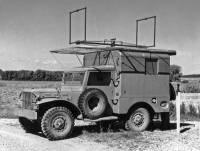Inhaltsverzeichnis
Direction Finding
Direction findung systems were used in the Swiss Army for various purposes. On one hand in the signal intelligence (SIGINT), on the other hand for aircraft location and assistance during the landing approach by the Air Force.
In the first years, the direction finding equipment was given simple abbreviations, usually two letters, so LP stands for the Langwellen Peiler (Longwave DF). According to the new naming scheme, which was introduced in 1951, direction finding systems got designations P-7xx, followed by a two-digit number.
The information about the direction finding systems and the background of their military use are sparse. I am always thankful for additional information, technical documents and operating instructions,photographs of DF installations and would even have some space for one or another direction finding receiver in my collection
Direction Finding Equipment List
| P-700 (LP) | P-710 (PV-1-B) | P-720 (PE-484) | P-730 (R & S NP 5) |
| P-701 (KP) | P-711 | P-721 (PST-476) | |
| P-702 (BP) | P-712 (NP-4S) | P-722 (R & S NP 4) | P-732 (SFP 5000) |
| P-703 (WP) | P-713 (NP-3) | P-723 (PST-638) | P-733 (SFP 5200) |
| P-704 (HS) | P-714 (AD 200) | ||
| P-705 (GTC) | P-715 | P-725 (1) | |
| P-706 (AGM) | P-716 (SCR-269 Radio Compass) | P-725 (2) | P-736 (R & S PA-025) |
| P-707 (BB) | P-717 (AN / ARC-21A) | ULPE (PA004) | |
| P-708 (LP Tfk) | P-718 (AN / ARN-7 Radio Compass) | P-728 (PA003) | |
| P-709 (SCR-634A) | P-719 (AGA Voice beacon) | P-729 (SFP 218.44) |
Direction finding systems were used for various purposes.
On the one hand, the Monitoring service used direction finding to detect suspicious foreign signals, in WWII especially those operating in Germany, or signals from within the country which could originate from spy radio stations. Near-field direction finding was carried out after a rough localisation of the transmission with direction finding vehicles, which could approach a suspicious transmitter site as inconspicuously as possible in the neighbourhood. Direction finding receivers carried inconspicuously by the defence signalmen could then be used to determine the location between or within individual buildings.
On the other hand, direction finding was used by the air force to localise aircraft, they were used in permanent installations and at military airfields, where direction finders were mounted in vehicles.
Vehicles
| Designation | Radio system | Introduction | ||
|---|---|---|---|---|
| Mobile DF 29 Long wave | Three light trucks Berna were equipped in 1929 with a Telefunken direction finding system based on the E358N DF receiver and a round frame antenna on the roof with manual drive; a AR245 transmitter was installed for direction finding commands & result transmissions. | Receiver: E358N; Transmitter ARS245 | 1929 |  |
| HF DF P-701 | The Telefunken P57N shortwave direction finder was mainly used for aircraft direction finding at airfields and near field DF in the attempts to locate spy transmitters. | Receiver: P57N | 1935/37 | |
| LF DF P-708 Long- / Mediumwaves | The long-wave direction finder P101aN from Telefunken, installed in a Berna light truck, was mainly used for aircraft direction finding at airfields. | DF Receiver: E383N Monitoring Receiver: E417N | 1938/39 |  |
| HF DF P-711 | The shortwave direction finder P-711 from Marconi / Hasler AG was also mounted on two Dodge WC vehicles. | P-711: Marconi DFg 29 | 1949 - 1970 |  |
| DF P-723/m Long-, medium-, shortwave | The Telefunken - direction finder Telegon IV, military designation P-723, installed in VW Bus T1 | P-723: PST-638 | 1967 - 1985 |  |
| DF DF-725 | The Telefunken direction finder Telegon IV, extended with attachments to cover the military VHF ranges, panoramic sighting device and frequency counter installed in a Unimog S light lorry, was given the military designation P-725 | P-725/m: PST-638 UK 638/80/1 UK 638/180/1 | 1971 - 1986 |  |
Further information
- Funkpeilung - Die Geräte und Anlagen der Schweizer Armee bis 1945, Eduard Willi, HB9YQ
